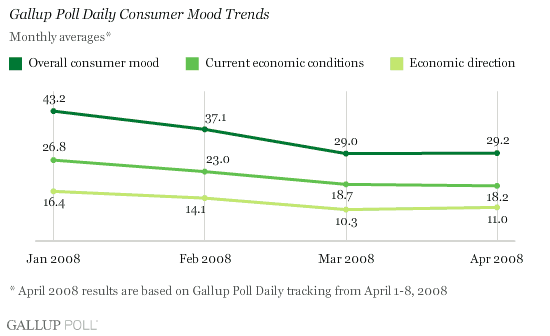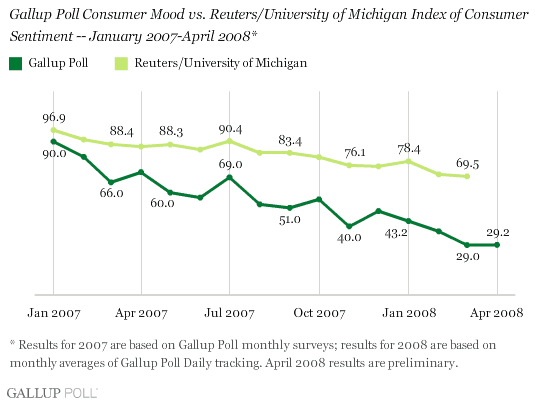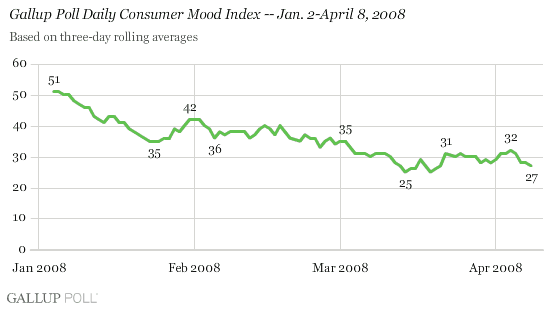PRINCETON, NJ -- ║┌┴¤═°'s measure of Americans' positive economic mood stands at a gloomy 29.2 in ║┌┴¤═° Poll Daily tracking interviewing from April 1-8, 2008, similar to the 29.0 reading for all of March.

The measure -- reflecting Americans' positive perceptions of the U.S. economy -- was 37.1 in February and 43.2 in January.
This measure is one way to summarize ║┌┴¤═°'s daily tracking of the public's economic mood, which relies on two questions about the U.S. economy: 1) rating current economic conditions and 2) perceptions of whether the economy is getting better or worse. It indicates that the downward trend in consumer attitudes since January has leveled off (albeit at very negative levels).
The overall consumer mood rating is based on the sum of the positive answers to these two economic questions. The rating has a maximum possible score of 200 (under the ideal conditions that 100% of Americans rate the economy "excellent" or "good" and, separately, that 100% say it is "getting better"). The highest recorded score in ║┌┴¤═° trends for these positive measures since the component questions were established in 1992 is 140 in January 2000.
There has been a generally strong correspondence between the direction of ║┌┴¤═°'s economic mood measures and the monthly Reuters/University of Michigan Index of Consumer Sentiment. Thus, given the results of ║┌┴¤═°'s roughly 4,000 interviews conducted thus far in April, it would be unusual if the preliminary April consumer sentiment figures being released to Reuters/University of Michigan subscribers on Friday, April 11, show either a major improvement or a deterioration in consumer attitudes since March.

Since the start of ║┌┴¤═° Poll Daily tracking on Jan. 2, 2008, ║┌┴¤═° has released daily updates on consumer confidence based on three-day rolling averages. The averages reported for January through April obscure some important shifts that are evident in the detailed trend. Among these are the findings that consumer confidence fell sharply for the first three weeks of January, after which it regained nearly half its losses in the last week of January. Confidence slid again at the beginning of February, but then held steady through the remainder of the month, only to descend in the first half of March to the lowest level seen for the year. Confidence again rebounded somewhat toward the end of March and remained at that slightly improved level through early April.

Confidence has softened slightly in the past few days (since April 6), although it is yet unclear whether this is a minor dip or the beginning of another substantial slide. While the average ║┌┴¤═° consumer mood score from April 1-8 (29.2) is similar to the 29.0 for all of March, consumers are a bit more negative about the economy at the start of April than they were at the start of March. This establishes the possibility that -- if current attitudes persist or descend any further -- April could produce the lowest consumer confidence scores of the year thus far.
For more details about ║┌┴¤═°'s consumer confidence polling and how it compares with other commonly used measures of consumer confidence, ).
Survey Methods
Approximately 1,000 national adults are interviewed each night for ║┌┴¤═° Poll Daily tracking (including weekdays and weekends, but not major holidays), of which a random half-sample of approximately 500 national adults are asked for their economic views. The results are reported in continuous three-day rolling averages.
The aggregate of ║┌┴¤═° Poll Daily tracking interviews from April 1-8 reported here is based on interviews with 3,979 national adults. For results based on this sample, the maximum margin of sampling error is ┬▒2 percentage points. The January, February, and March monthly averages reported here each include interviews with at least 14,000 national adults. For results based on samples of this size, the maximum margin of sampling error is ┬▒1 percentage point.
In addition to sampling error, question wording and practical difficulties in conducting surveys can introduce error or bias into the findings of public opinion polls.
The survey methods for ║┌┴¤═° Poll Daily tracking are similar to those of The ║┌┴¤═° Poll. The poll relies on live (not automated) interviewers, random-digit-dial (RDD) sampling, cell-phone sampling to reach those in cell-phone-only households, and a random selection method for choosing respondents within a household. Additionally, ║┌┴¤═° Poll Daily tracking includes Spanish-language interviews for respondents who speak only Spanish, includes interviews in Alaska and Hawaii, and relies on a multicall design to reach respondents not contacted on the initial attempt.
